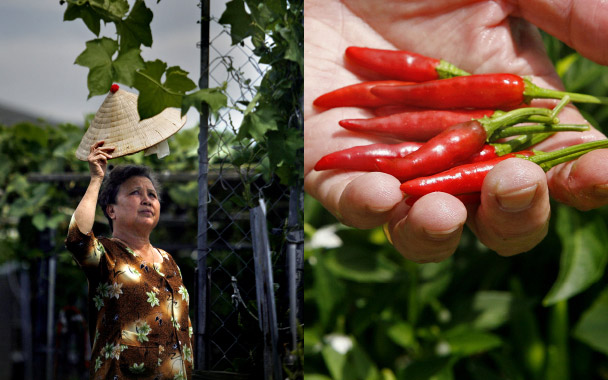On the east side of New Orleans, three-and-a-half years ago, 90 percent of the homes in the Vietnamese community had gardens, says local activist Peter Nguyen. The green onions, Malabar spinach, daikon, cilantro, mint, Thai basil, and countless Asian vegetables that contribute to Vietnamese home cooking were grown there. Every Saturday at dawn, a few dozen growers gathered to sell their produce at the neighborhood market, and for the elders—many of whom were resettled in New Orleans after the Vietnam War—their gardens were a treasured link to the country they had left behind. But the younger generation wasn’t much interested in what they considered to be the hard labor of growing, and the elders wondered how they could involve their children and grandchildren so that the traditions would continue. Then Hurricane Katrina blew through, and three decades of work tending the land was lost.
It might have remained lost if the voice of Reverend Vien Nguyen, of the Mary Queen of Vietnam Catholic Church, hadn’t rung out when the city, in its attempt to move forward after the disaster, proposed turning the devastated New Orleans East neighborhood into green space for the city at large. “Father Vien said, ‘You can’t do this. This is our home. Give us time to rebuild,’” says Nguyen, now director of the parish’s nonprofit Mary Queen of Vietnam Community Development Corporation (MQVN CDC). “Our community put a lot of thought into planning beyond what it needed to simply get by in the present and decided that the future called for senior housing, a charter school, a health center, and a community garden that would serve to unite us culturally.” The idea for the 28-acre Viet Village Urban Farm was born. It would include acres of individual garden plots; space for commercial growers of Asian produce and farmers raising poultry and goats in the traditional Vietnamese way; a covered market area (including a place for local Vietnamese restaurants to set up food stalls during the market); and a children’s playground, where the elders who grew food could bring their grandchildren to learn about farming. There are also plans to integrate the farm into school programs, Peter Nguyen says.
An ambitious project like Viet Village required ambitious and dedicated partners and funders. Twenty acres adjacent to the Mary Queen of Vietnam Church were purchased from the city, and eight additional acres will be leased long-term. “We strongly believed in the importance of this project, to our city and its future,” says Daphne Derven, Executive Director of The New Orleans Food and Farm Network (NOFFN), a grassroots organization that promotes sustainable agriculture through its plethora of workshops and programs, and that was an early and key supporter of Viet Village. NOFFN acquired a grant from the Blue Moon Foundation that helped provide in-depth technical assistance from top landscape-architecture firm Spackman, Mossop + Michaels, Louisiana State University’s Robert Reich School of Landscape Architecture, and Tulane University’s School of Architecture affiliate City Center. Their Viet Village design won the 2008 Analysis and Planning Award for Excellence from the American Society of Landscape Architects.
“The goal is to make the Viet Village Urban Farm an exemplar of sustainable technology,” says Spackman, Mossop + Michaels partner Elizabeth Mossop, who is also director of LSU’s School of Landscape Architecture. To deal with the site’s wetlands, she says, “We combined a system of low-tech drainage canals with a high-tech system of recycling that water for irrigation. A green-waste facility for composting was developed. The design for the structures is driven by the technology involved—collecting and recycling water, a passive solar design—and the look is modern.”
Other early champions of Viet Village are the nonprofit Marketumbrella.org, which is assisting in the development of the open market, and local chef John Besh, who has pledged to source many of the vegetables they use in their restaurants, including August and Lüke, from the Viet Village farm. Lüke’s executive chef Steve McHugh is leading the effort. And volunteers from all over the city will help to build the farm structures and work the soil (which is heavy clay) to make it arable.
Funding remains the organization’s biggest challenge, along with the administrative concerns that consume even the simplest projects in a city where recovery is a labyrinthine process. “Our hope is to have the farm completed by 2011,” Peter Nguyen says, “but in the meantime it will open in stages. A community member has donated a three-acre parcel as a community garden until the farm is ready.” Is he worried, I ask, that the elders will have a tough time growing on the new land? Nguyen laughed. “Even when they only had gravel in front of a FEMA trailer, they’d put some topsoil on it and pretty soon it was a garden. Wherever they are, things will grow.”
In New Orleans, visit the Vietnamese market on Saturdays from 5 A.M. to 9 A.M. at 14401 Alcee Fourtier Boulevard at Peltier. For a listing of other farmers markets in the city, visit Go Green Nola! (gogreennola.org).



 Pinterest
Pinterest


